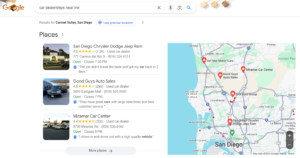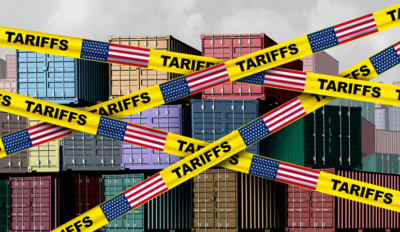8 Top Car Dealership Marketing Strategies

Gaining high-quality leads for your car dealership has become more challenging and competitive than ever. Many factors are influencing today’s car buyers. Interest rates aren’t as favorable to borrowers. Many locations have an inventory surplus increasing days on lot numbers, and consumers are keeping cars longer. Savvy businesses must transform their car dealership marketing to attract and convert customers.
You have many options for advertising, as digital marketing for car dealerships has become the foundation. However, only a small percentage of consumers are in the market at one time, so your tactics must work to create awareness and convert intent.
Whether you work with an agency or manage this in-house, you’ll need a flexible strategy that leverages multiple tactics across different channels, including your website. Using a mix of marketing tactics like email, SEO (search engine optimization), social media, and paid advertising ensures you reach customers in the channel they prefer. Doing so increases the chance for engagement.
Since every car dealership employs the same tactics, you must find ways to stand out among the competition. The best-performing dealers apply personalization and targeting technologies and innovative tools to increase their marketing effectiveness.
Let’s review eight ways to use traditional marketing channels creatively and introduce technology to spark new opportunities for your dealership.
In this article
- 1 1. Maximize Email Marketing Strategies for Car Dealerships
- 2 2. Engage Customers with Video Marketing
- 3 3. Create Engagement and Interest with Social Media for Car Dealership Marketing
- 4 4. Optimize Your Car Dealership Website for Conversions
- 5 Use cases for dealership chatbots include:
- 6 5. Implement Effective Sales Promotions for Car Dealerships
- 6.1 Loyalty Programs
- 6.2 Referral Programs
- 6.3 Exclusive Pre-Order Deals
- 6.4 Trade-In Promotions
- 6.5 Service Bundle Offers
- 6.6 New Customer Incentives with “First-Time Buyer Programs”
- 6.7 Online-Only Promotions
- 6.8 These are time-limited offers, so ensure there’s a sense of urgency. It can be what nudges someone from consideration to conversion. More tips for managing promotions include:
- 7 6. Boost Local SEO for Car Dealerships
- 8 7. Spend Effectively on PPC and Other Paid Advertising
- 9 Things to keep in mind for PPC dealership marketing:
- 10 8. Develop a Comprehensive Content Marketing Strategy for Car Dealerships
- 11 Building a strategy ensures you can consistently produce high-quality content. Your plan can include:
1. Maximize Email Marketing Strategies for Car Dealerships

For every $1 spent on email marketing, businesses see a return of $36. It has the greatest ROI of any car dealership digital marketing channel. Most dealers are already using email marketing, but you can optimize performance with personalization and targeting your campaigns to build relationships, increase engagement, and improve conversion rates.
By analyzing data such as browsing history, previous interactions, demographic information, and other behavioral triggers, you can tailor messages to individual preferences.
Examples of this email marketing for car dealerships that take this approach include:
- Deliver practical content: Send contacts how-to guides, financing tips, service specials, and maintenance advice aligned with the buying journey. This keeps them engaged with your dealership.
- Offer exclusive invitations: Invite them to VIP events, early access to new models, or personalized dealership tours, which makes prospects feel valued and more likely to engage.
- Implement automated communications: Build drip messaging campaigns that nurture leads over time with relevant content and offers based on the customer’s stage in the buying journey. You can use similar automation for service customers.
- Send promotions on specific cars: Highlight preferred vehicles like SUVs to family-oriented buyers or eco-friendly models to sustainability-conscious customers.
- Promote personalized incentives: Offer customers discounts on vehicles they’re interested in or financing options based on their credit profile.
- Include vehicle walkthrough videos: Target high-intent customers with model videos. For example, “Explore the New 2024 SUV with Our Exclusive Video Walkthrough.”
- Share snippets of educational blogs: Link posts in emails with a compelling hook so they’ll click on your website. An example subject line could be, “Need Help Deciding? Read Our Guide on Leasing vs. Buying.”
- Leverage CRM insights to send timely reminders: Use this technology to send emails about limited-time offers or alerts when a specific vehicle becomes available. These angles can increase the likelihood of conversion.
- Personalize follow-up messages: Deploy emails after test drives or inquiries. Address any specific concerns or questions discussed. These communications can develop trust and emphasize your ability to meet their needs.
- Let customer testimonials influence buyers: Assign these emails to leads in the consideration phase but have yet to decide. Try a subject line like “Hear What Our Happy Customers Are Saying.”
- Create a regular newsletter: These emails can include a mix of dealership and industry news as well as inventory updates, special offers, recent blog posts, and more. Customize the content for specific audience groups by demographic, behavioral, or psychographic segmentations. For instance, you can tailor content for first-time buyers who need more guidance. Repeat buyers could see messaging about upgrades and premium services.
You’ll need a robust email marketing platform for high-volume, personalized campaigns. Evaluate options based on ease of use, ability to develop drip campaigns, and automation capabilities.
2. Engage Customers with Video Marketing
Did you know that 91% of people watch videos to learn about products and services? This statistic demonstrates the power of video as an influencer. It’s visual and aural, so it engages multiple senses. It’s also a highly shareable content format and can live in many places — your website, social media pages, and paid advertising.
Video content as part of your auto dealership marketing strategy can include:
- Vehicle walkarounds
- Highlights of specific functions or features in explainer videos
- Your staff answering common questions about car buying
- Why buy from us videos
- Customer testimonials
- Showroom experiences
- Service department
- Your dealership in the community
You can elevate video marketing even higher with these creative options. They can dramatically improve your marketing effectiveness.
- Event invitations and recaps: Include a video teaser in an email inviting customers to a new model launch event. Send a recap video to those who couldn’t attend.
- Promotional offers: Highlight special deals or limited-time offers more dynamically and engagingly. A video in an email campaign could feature an animated countdown and highlight the details of a seasonal sale.
- Live streaming: Engage with your audience in real time, answer questions, and create a sense of immediacy. Your dealership could host a live Q&A session about a new model launch or offer a virtual tour of the dealership.
- Product launches and announcements: Generate excitement for new products with visually appealing and informative videos. Example: A sleek, professionally produced video highlighting the features of a new car model is highly shareable on platforms like Instagram, Facebook, and Twitter.
- Educational and how-to videos: Establish your dealership as a knowledgeable resource, building long-term customer relationships by providing value beyond just selling cars. An example would be Essential Maintenance Tips from [Your Dealership].
- YouTube ads (Pre-Roll, Mid-Roll, and Bumper Ads): Reach potential customers on YouTube with targeted video ads. Example: A pre-roll ad before a video might feature a new car model with a CTA to visit your dealership’s website.
- Video display ads: Place video ads on websites and apps within Google’s Display Network. Your dealership could use a video ad that plays within a news article, highlighting a special promotion or new vehicle feature.
- Social media PPC Ads: Run a video ad campaign on Facebook or Instagram promoting a summer sales event, targeting users based on demographics and interests.
- Landing page content: Increase conversion rates by embedding videos on landing pages used in PPC campaigns. A video on a landing page could explain a special offer, providing more context and encouraging visitors to take the next step.
Social media has become a discovery hotspot for consumers. One-third of people use it for this purpose. In car shopping,21% said social media directly influenced their purchase. Additionally, it’s an environment where people can get feedback from current customers.
You can use social media organically and as a paid advertising channel. One important rule is consistency when posting, responding, and engaging.
Here are some social media marketing for car dealerships ideas:
- Short videos of dealership happenings, like customers and their new vehicles, showroom reveals, community events, and experts answering questions
- Content from your blog that’s educational and useful
- Promotions and sales
- Employee spotlights
- Customer testimonials
- Photo galleries of vehicles
- Third-party content like car reviews
Again, this is a channel most auto sellers use. What’s going to make your profile stand out is being consistent with your activity in posting, responding, and engaging.
Follow these best practices for using social media for car dealership marketing include:
- Post regularly and use a scheduler to make it easy.
- Include your content, promotions, and third-party articles from trusted publications. Use the 60-30-10 model: 60% of posts should be original content, 30% third-party, and 10% promotional.
- Engage when people comment on posts; even if they have a complaint, tell them you’ll directly message them to follow up.
- Keep images, branding, and content on your profile consistent and fresh.
Once you have an active profile, consider social media ads. You can target people based on demographics, geography, interests, and more.
4. Optimize Your Car Dealership Website for Conversions
An appealing, modern website often creates the first impression for car buyers. It should deliver a positive experience, be easy to navigate, and always be up-to-date. Focus on what the customer wants to do, not what you want them to do.
Most people start their buying journey online and prefer to complete as many steps as possible of the buying process virtually to save time at the dealership. The credit pre-approval button is one of the most clicked items on dealership websites.
When a car buyer prequalifies, it impacts their decision to buy. An industry study found that 93% of consumers said being prequalified would be useful, and 68% noted it would make them more confident about buying.
Some must-haves for your website include:
- Mobile-friendly and responsive
- A limited number of pop-ups
- Clear and obvious CTAs; too many create confusion
- High-quality images and video
- Detailed vehicle descriptions
- Intuitive UX (user experience)
- Top information your user wants that doesn’t require lead forms, which creates friction
- Digital credit solutions
With this in mind, you can increase your visitor-to-sales ratio.
Another way to optimize your website for conversions is to use a chatbot. You can embed chatbots into your website to provide continuous customer support. Choose one that uses conversation AI to interpret human inputs. It can’t do everything a person can, but it can deliver information quickly. It’s another dealer tool that supports overall success in customer service.
Use cases for dealership chatbots include:
- Providing answers to common customer questions: These could consist of inventory, queries about model performance, or information about the dealership’s services.
- Car budgeting calculations based on user inputs: Chatbots can help buyers understand their budget capacity. Having this as part of a chatbot rather than someone completing a form and waiting on a response hooks them early in the funnel.
- Beginning the financing process: If you have a consumer on your website who’s ready to buy, you want to make it easy for them to finance on their terms. Chatbots can guide people through the financing process.
- Appointment scheduling: Chatbots can also be scheduler assistants for test drives and services.
- Helping customers find the right model with a quiz: Many people on your website aren’t sure which car is right for them. Chatbots can initiate a quiz for drivers, asking them about their preferences and needs. Once complete, they’ll receive a recommendation and links to learn more.
5. Implement Effective Sales Promotions for Car Dealerships
Promotional strategies are a frequent component in dealership digital marketing. They can boost foot traffic, move out inventory, or entice hesitant buyers with special offers. Increase their efficiency and effectiveness with targeted, personalized promotions and special offers.
Here are some compelling examples of sales promotions you can tailor to specific customer segments.
Loyalty Programs
- The strategy: Offer returning customers special deals like a discount on their next vehicle purchase, free maintenance services, or extended warranties.
- How to personalize: Send personalized offers to repeat customers based on their purchase history, such as a trade-in bonus for their current vehicle or a discount on a model upgrade.
Referral Programs
- The strategy: Promote cash rewards, service credits, or a discount on their next purchase when they refer a friend who buys a car from the dealership.
- How to personalize it: Encourage satisfied customers to refer friends by sending them personalized messages acknowledging their past purchases and explaining how they can benefit from the referral program.
Exclusive Pre-Order Deals
- The strategy: Give customers a chance to pre-order new models before they hit the lot, often with special incentives, including priority delivery.
- How to personalize it: Invite customers interested in similar models or those due for a vehicle upgrade to early access based on their ownership timeline.
Trade-In Promotions
- The strategy: Provide an additional trade-in bonus or guarantee the highest trade-in value for customers looking to upgrade to a newer model.
- How to personalize it: Target customers with older vehicles or those whose leases are about to expire with personalized offers emphasizing the ease of trading in their current vehicle for a newer one.
Service Bundle Offers
- The strategy: Include complimentary maintenance services like oil changes, tire rotations, or inspections for a certain period by purchasing a new or certified pre-owned vehicle.
- How to personalize it: Delivers these deals to customers who value long-term savings or who have previously purchased maintenance plans.
New Customer Incentives with “First-Time Buyer Programs”
- The strategy: Extend special financing options, cash-back deals, or extended warranties for first-time car buyers.
- How to personalize it: Identify and target first-time buyers through data such as lack of trade-in history or entry-level model interest. Offer them educational content alongside the promotion to guide them through the buying process.
Online-Only Promotions
- The strategy: Create discounts or incentives for customers who engage online, such as a discount code for those who book a test drive or inquire through your website.
- How to personalize it: Use data from online behavior, such as which pages they visited or cars they viewed, to send personalized promotions that encourage them to take the next step online.
These are time-limited offers, so ensure there’s a sense of urgency. It can be what nudges someone from consideration to conversion. More tips for managing promotions include:
- Adjust campaign budgets based on car-buying trends, so you concentrate on deals with the greatest appeal.
- Create unique offers that align with specific demographics. Some examples are special rebates for college graduates, teachers, or families.
- Consider a price-match guarantee to attract interest.
- Make it easy for someone to review all the promotion qualifications and begin the sales and finance process online.
- Be strategic with electric vehicle promotions by emphasizing your deals, government rebates, and accessibility of charging and maintenance.
- Communicate transparently with these offers regarding pricing and rates, which conveys fairness and trustworthiness. These are characteristics that consumers appreciate.
6. Boost Local SEO for Car Dealerships

Local SEO is pivotal for auto dealer marketing strategies. According to Google, 92% of car buyers research online before purchasing. You’ll need highly optimized web pages and content to capture this interest.
Improving SEO entails the creation of content optimized to specific keywords as well as technical elements in the backend of your website. SEO is a long-term car dealership marketing strategy but worth the effort. Appearing in organic results increases the chances of clicks and showcases your credibility.
Optimizing for local SEO also helps you enter Google’s “Map Pack,” a SERP (search engine result page) feature. It’s above the organic results and shows your dealership’s basic information and placement on the map.
You can maintain your rankings and improve them by:
- Having a fast-loading website: Slow sites can see ranking decreases. Because your website is image-heavy, this can be a concern. Unnecessary script and code can also be an issue. Always optimize images for quality but decrease their size. Test your website’s loading time regularly to ensure site speed stays stable.
- Developing content that optimizes for long-tail keywords: These may have less search volume but lower competition. Ideas for this include specifics around features of individual vehicles, models, and geographic descriptors. Instead of using “Toyota Camry Sacramento,” try “Toyota Camry XLE Sacramento.”
- Adding internal links throughout the site: Internal linking can boost rankings. When applying them, use anchor text links and prioritize your most important pages as the link. Every page or blog should have two or more internal links.
- Delivering an ideal mobile user experience: Google uses mobile-first indexing, which means they use this version to rank. Since 71% of customer touchpoints with dealers happen on mobile, your website’s design should be mobile first, paying attention to every element of user experience.
7. Spend Effectively on PPC and Other Paid Advertising
Let’s look at how to use paid ad types to boost dealership marketing.
PPC
Car dealerships use PPC to capture attention in search, too. If these listings are timely and of interest, car buyers may click. It’s also a highly competitive medium that can deliver ROI when executed effectively.
Things to keep in mind for PPC dealership marketing:
- Choose the best keywords that identify local search terms and have a good volume while being less competitive.
- Ensure your ad copy includes valuable information related to the search term.
- Build unique landing pages for customers to arrive at after the click.
- Review your PPC performance data and adjust based on what keyword sets and ads generate the best leads.
- Add negative keywords to your campaign to avoid unqualified clicks.
- Use geographic targeting based on your service area.
Since the paid search landscape can be competitive, it’s best to diversify ad spend. Consider these ad types.
Geofencing
Geofencing targets an audience by geography by creating a virtual fence around a physical area. Consumers with location services enabled would see an ad if they were in this space. You can use geofencing in several ways.
First, you can fence your competition. With the right message, consumers may keep shopping at your dealership. A second option would be to target specific audiences in areas where they may spend time. For example, if you want to focus on buyers who drive family-friendly cars, you could fence local sports complexes.
A third way to use geofencing is to put one around your dealership. You can deploy location-based retargeting when you do this. Because they were in your fence, they will later receive pertinent ad content to get them back to your website or showroom.
Geofencing can be highly effective, with mobile ads garnering twice the CTR (click-through rate) over those that don’t. Experiment with this as a car dealership marketing strategy.
Geotargeting
Geotargeting ads rely on serving ads to people with certain geographic spans, usually ZIP codes. You can personalize this at this level based on the demographics of the community. Those living in urban areas may have different car buying needs than those in rural ones, for example.
8. Develop a Comprehensive Content Marketing Strategy for Car Dealerships
Content marketing will fuel much of car dealership digital marketing. It supports social media, local SEO, website optimization, email marketing, paid advertising, and more.
Building a strategy ensures you can consistently produce high-quality content. Your plan can include:
- A content calendar that includes information such as keywords to focus on, the funnel stage, and the intended audience
- Topics to cover, such as car-related posts, maintenance tips, information about financing, industry trends, and how-to articles
- Defined content requirements, such as length, internal linking, tone and voice, and other best practices
Content marketing can attract new and existing visitors to your website. With a content library, people stay longer and get to know your business. Content that’s relevant, timely, and influential is vital in digital marketing for car dealerships. Technology can help here, too. Use automation workflows for publishing and posting.
Car Dealership Marketing Strategies Deliver Opportunities
Get more insights for your dealership by visiting our blog.



